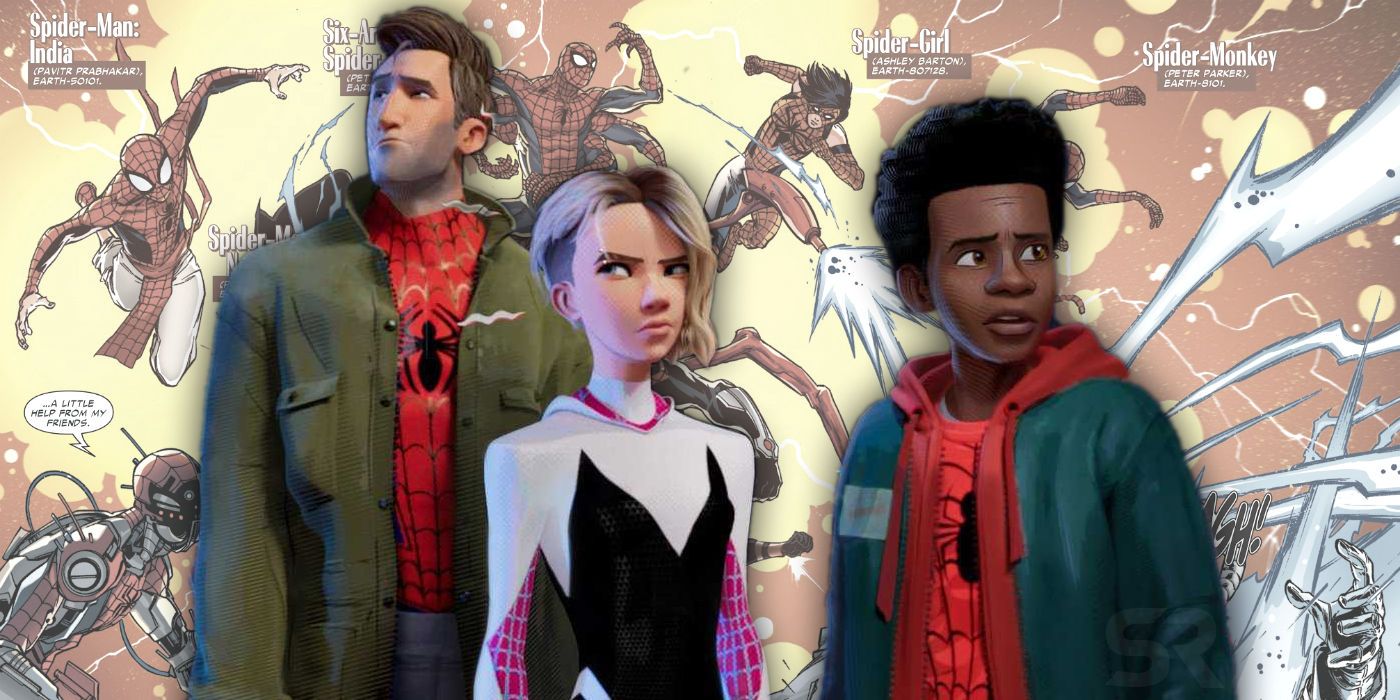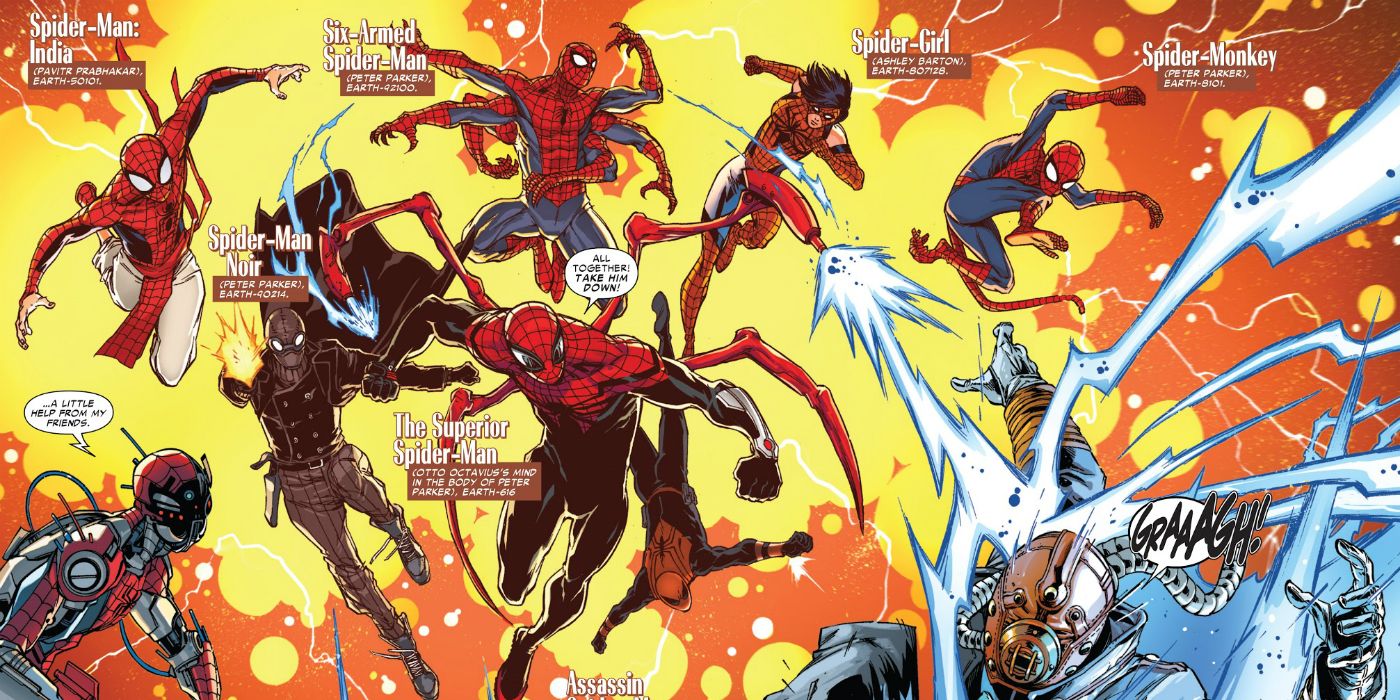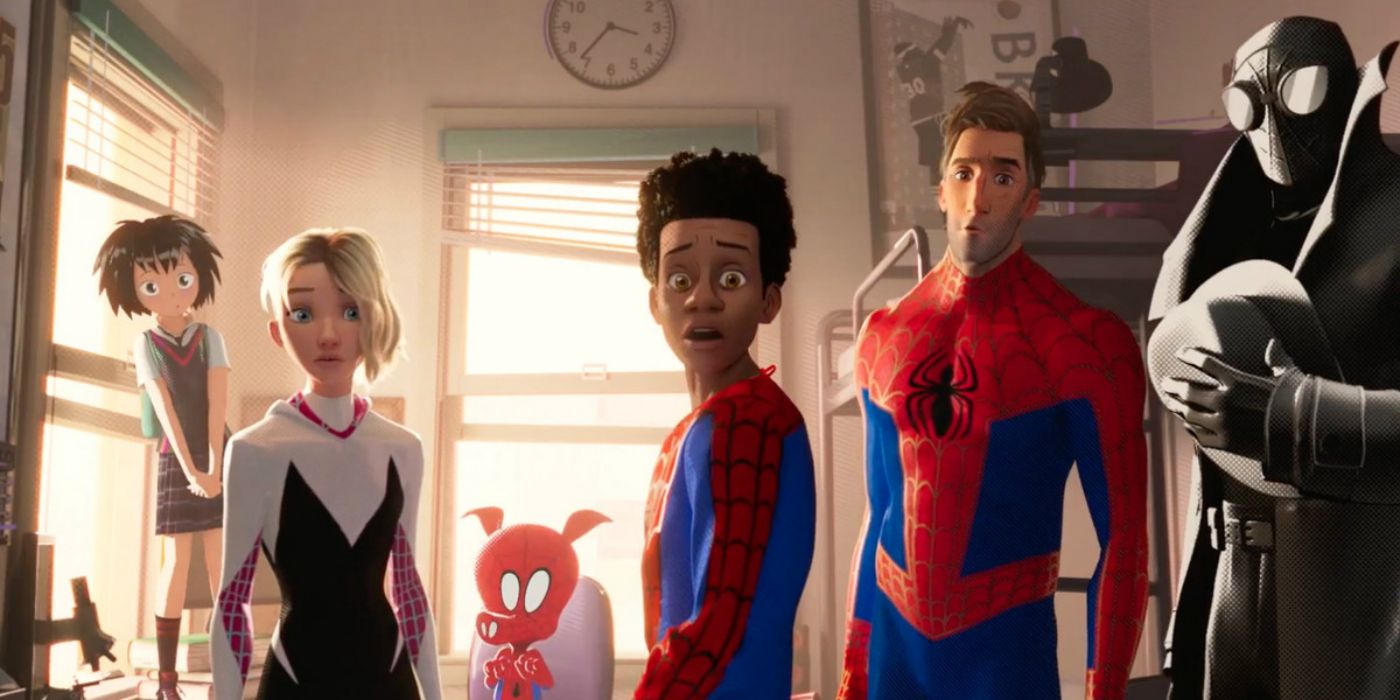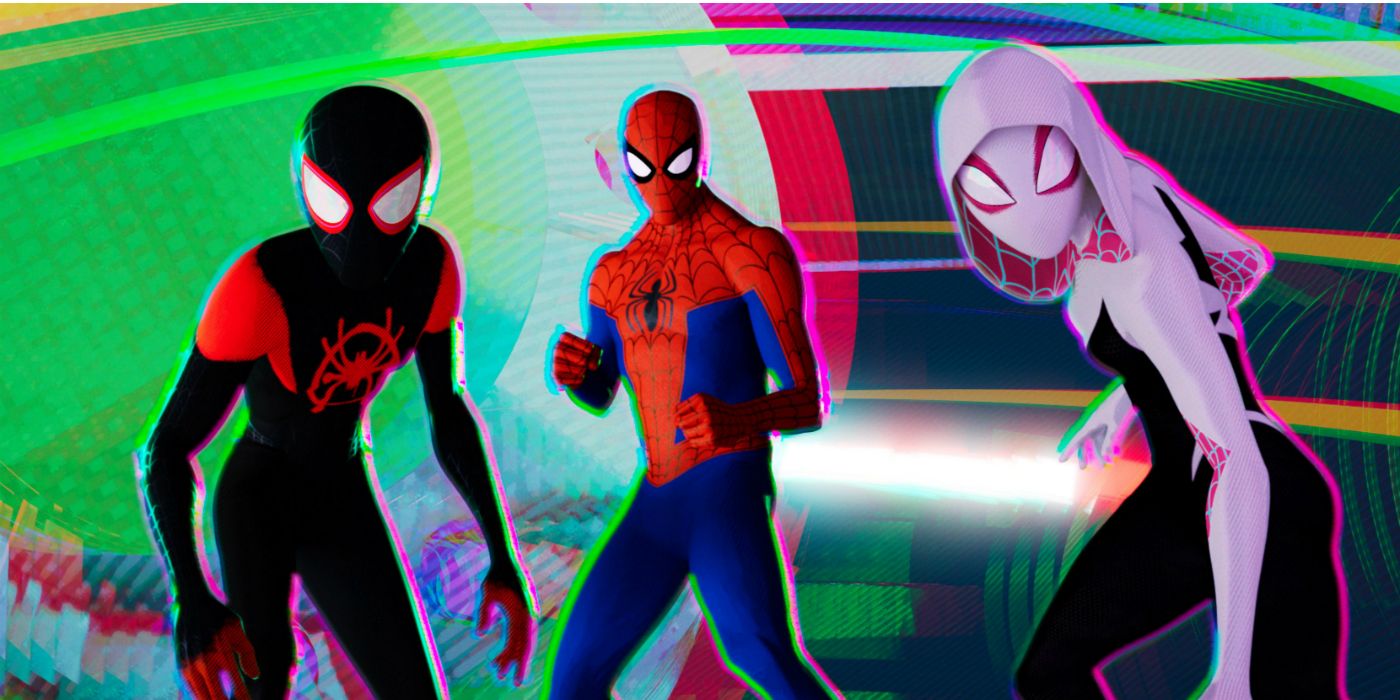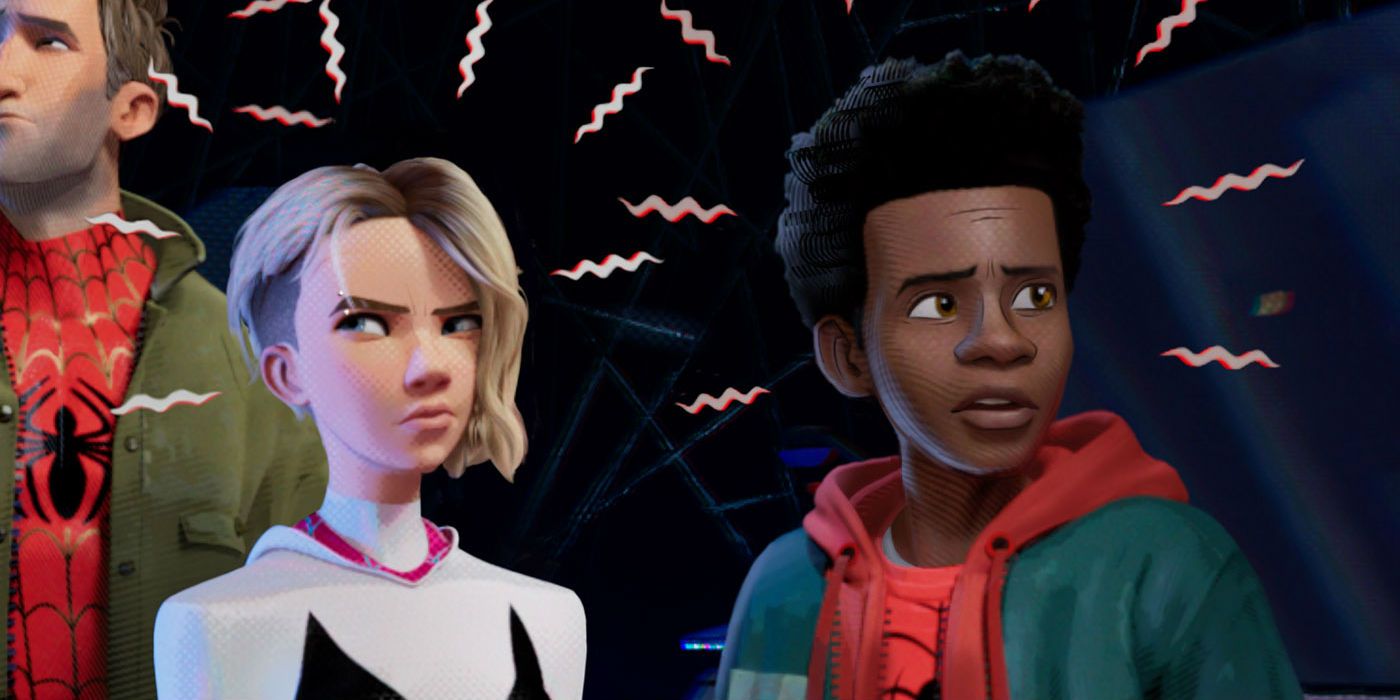Sony Pictures' animated Spider-Man: Into The Spider-Verse movie is a tremendous film inspired in large part by Dan Slott's 2014 "Spider-Verse" comic book event, but how does it compare? It features a talented voice cast including Shameik Moore as Miles Morales, Jake Johnson as Peter Parker, and Hailee Steinfeld as Spider-Gwen. By the looks of it, the movie will be a box office success, after already becoming one of the highest rated superhero movies of all time.
At its core, the idea behind a Spider-Verse story is a simple one; it's an adventure that unites different versions of Spider-Man from different realities. In the comics, Marvel has launched countless iterations of the wall-crawler; there have been versions of Spider-Man set in 1602 and 2099, ones where he's a cyborg and a zombie, and Spider-Ham isn't even the only anthropomorphized animal version. There's a Spider-Monkey, as well, but that's not the only crazy idea for Spider-Man that Marvel has come up with over the years.
Related: 10 Best Spider-Men NOT In The Spider-Verse Movie
Sony's movie draws upon this concept by bringing together a handful of different iterations of Spider-Man, choosing ones with distinct visual styles so as to have real fun with the animation. But how does Spider-Man: Into The Spider-Verse compare to the original comic book event? Here, we're going to compare and contrast Dan Slott's epic - and its associated tie-ins - with the latest blockbuster movie.
- This Page: Marvel Comics' Spider-Verse Versus Sony's Animated Film
- Next Page: How Sony's Spider-Verse Came Together & What It Means For The Future
The Core Concept Of Spider-Man: Into The Spider-Verse Is Different
It's important to note that the central concept underlying the comic book story and the movie are subtly different. The "Spider-Verse" event was intended to be a celebration of every version of Spider-Man there had ever been, whether in the comics or in animation. That meant an incredible number of Spider-Men were involved in the story - from Spider-Man India to an Assassin Spider-Man, from a Spider-Man possessing the almost-unlimited power of Captain Universe to a Six-Armed Spider-Man. Although Slott didn't have the license to use previous big-screen versions, thus meaning there wasn't an actual appearance from Tobey Maguire's Spider-Man or Andrew Garfield's, throwaway dialogue nevertheless implied the two were there. Meanwhile, Marvel took advantage of "Spider-Verse" as an opportunity to create a wide range of brand new Spider-Men and Spider-Women - the most successful of which was Gwen Stacy's Spider-Gwen.
Related: Into the Spider-Verse's Stan Lee Cameo/Tribute Is One Of The Best
In contrast, Spider-Man: Into The Spider-Verse serves two functions. Firstly, it's an origin story for Miles Morales' Spider-Man, and as such has a much tighter focus than Slott's event; everything is viewed through the prism of how it affects the central hero. Secondly, it's designed to embed the Spider-Verse in the popular consciousness, to introduce general moviegoers to the idea that there's a whole multiverse's worth of Spider-Men out there who could yet appear on the big screen. That means the scale of it all is reduced a little, and the adventure is based in a single dimension rather than hopping from reality to reality.
Less Is More In Spider-Man: Into The Spider-Verse
The most notable result of that change in focus is that there are far fewer different Spider-Men. In fact, the film really only stars a handful of Spider-People:
- Miles Morales' Ultimate Spider-Man is, of course, the star of the film - when he was just a secondary (possibly even tertiary) character in the comic book event.
- There are two versions of Peter Parker, one of whom seems loosely inspired by Slott's "Big Time" version - where Peter has achieved fame and success. He's swiftly killed off, however, and replaced by a down-on-his-luck iteration of the wall-crawler who's very close to giving up on everything.
- Spider-Gwen, the breakout star of the 2014 "Spider-Verse" event, is another key figure in the film; she befriends Miles, but it's not hard to notice the occasional sparks between the two.
- Spider-Ham is a funny animal parody of Spider-Man, played out in entertaining style. He played a major role in the "Spider-Verse" event too, and Marvel originally intended to launch an ongoing Spider-Ham comic in the wake of the event. They pivoted towards Spider-Gwen when they saw how well she was received, however. A Spider-Ham spinoff could happen.
- Spider-Man Noir is played well, and is a darker version of the wall-crawler who - in an amusing touch - is unable to work out how to deal with a world of color.
- Peni Parker is a young girl who's bonded with the Sp//dr android. Like Spider-Gwen, Peni was created in one of the "Spider-Verse" tie-in comics and has become a fan-favorite.
Related: Chris Pine's Surprise Role In Spider-Man: Into The Spider-Verse Explained
The "Spider-Verse" event carefully treated each character differently, with tie-in issues giving artists a chance to experiment with the worlds of the different Spider-Men. Spider-Man: Into The Spider-Verse takes a similar approach, with each character rendered using a different animation style. There's a sense in which it's almost a collage film, a combination of completely different artistic styles. Somehow, though, the animation team made it work.
Page 2 of 2: How Sony's Spider-Verse Came Together & What It Means For The Future
How The Spider-Verse Comes Together
This tighter focus means the driving force for the story is very different. In the comics, "Spider-Verse" came about when the Spider-Men became aware they were being hunted by inter-dimensional predators known as the Inheritors. The Inheritors fancy themselves as masters of the Multiverse, and they dine on the life essence of people whose powers are associated with animals. They find spiders particularly satisfying because the spiders are tied to the Great Web of Destiny that transcends the Multiverse. The Spider-Men (who were referred to as Spider-Totems by the Inheritors) realized they'd be slaughtered if they didn't work together to somehow stop these fearsome enemies. And so, they united to fight the Inheritors together.
Related: Sony's Three Spider-Man Movie Universes Explained
In contrast, Spider-Man: Into The Spider-Verse is set almost entirely within Miles Morales' dimension, and it sees Kingpin and Doctor Octopus experiment with reality-warping technology in order to resurrect Kingpin's wife and son. It's a much more personal and intimate concept. The stakes are still high, though; while Doctor Octopus believed there was a risk of destroying just the one reality, Spider-Man: Into the Spider-Verse's post-credits scene hinted that the villains could have triggered the collapse of the entire Multiverse. And this could lead into Spider-Man: Into the Spider-Verse's sequel, which may ultimately see the Inheritors come into play in Sony's new animated universe.
The Future Potential For Spider-Verse Is The Same
In the comics, the "Spider-Verse" was a defining moment for Marvel's Spider-Man franchise. Spider-Man has always been Marvel's most popular hero, but the comic book publisher had struggled to turn that success into a well-performing range of comic books, ones that could stand apart from the core series. That's largely because the focus has always been upon Peter Parker himself, with an occasional emphasis on members of his supporting cast. Other characters have typically failed to resonate well enough with readers to launch anything more than a miniseries.
Related: Spider-Verse's Old Peter is The TRUE Spider-Man
All that changed as a result of "Spider-Verse," however, with Marvel successfully launching a range of comic books featuring secondary characters and alternate-reality versions of the wall-crawler. Even today, the Spider-Man franchise includes comic books dedicated to Miles Morales, Spider-Gwen, and an alternate-universe version where Peter Parker is married to Mary Jane, not to mention the fact that they also have a daughter. (This is a story arc that's set up in Spider-Man: Into the Spider-Verse and could pay off in a sequel.)
Spider-Man: Into The Spider-Verse has exactly the same kind of potential. It's a launchpad for any number of new animated movies, and it's no surprise that Sony already has a Spider-Man: Into the Spider-Verse sequel and spinoff - both reportedly featuring Spider-Gwen - in the works. Assuming the film performs well at the box office, which seems like a safe bet given current predictions, it can easily lead to any number of new movies. Indeed, the post-credits scene explicitly teased that potential, introducing Spider-Man 2099 and giving him the ability to jump between dimensions.

